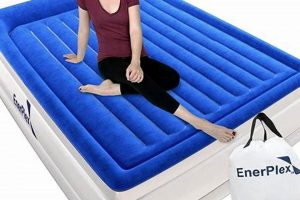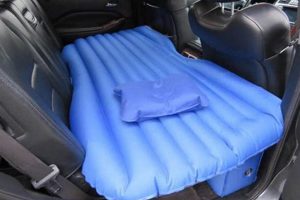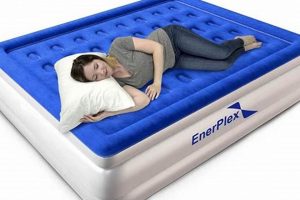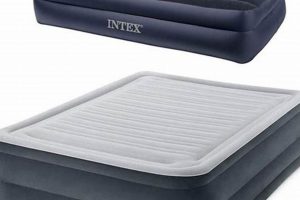Locating punctures in inflatable sleeping pads is a crucial step in maintaining its functionality and usability. This process involves identifying the source of air leakage, typically a small breach in the material that allows air to escape, rendering the mattress deflated and uncomfortable. The need arises when an inflatable sleeping surface fails to hold air for an extended period, indicating a compromise in its airtight seal.
Successfully identifying these punctures offers multiple benefits. Foremost is the ability to repair the damage, thereby extending the life of the product and avoiding the cost of replacement. Additionally, locating and fixing the source of air loss restores the comfort and support provided by the mattress, allowing for a restful sleeping experience. Historically, techniques for detecting breaches have evolved from simple observation to more sophisticated methods involving soapy water or specialized detection equipment.
Effective strategies for locating these punctures, repairing the damage, and preventing future occurrences will be explored in subsequent sections. The implementation of these methods will ensure the continued functionality and longevity of the inflatable sleeping surface.
Locating Air Leaks
Effective strategies for identifying breaches in inflatable mattresses enhance the lifespan and usability of the product. Utilizing methodical techniques ensures the detection of even the smallest punctures.
Tip 1: Visual Inspection. Begin with a thorough examination of the entire surface. Look for obvious signs of damage, such as tears, cuts, or abrasions. Pay particular attention to seams and areas that experience frequent stress.
Tip 2: Auditory Detection. In a quiet environment, inflate the mattress fully and listen closely for hissing sounds. These sounds often indicate the location of an air leak. Move slowly and deliberately to pinpoint the exact source.
Tip 3: Soapy Water Test. Mix a solution of mild soap and water. Apply the solution to small sections of the inflated mattress. The formation of bubbles indicates the presence of an air leak. Mark the area for repair.
Tip 4: Submersion Method. If feasible, submerge the inflated mattress in water, one section at a time. Observe for streams of air bubbles emanating from the leak. This method is particularly effective for locating smaller punctures.
Tip 5: Pressure Test. Inflate the mattress to its maximum recommended pressure. Monitor the pressure over a period of several hours. A significant decrease in pressure suggests the presence of a leak that requires attention.
Tip 6: Use a Leak Detector. Consider utilizing specialized leak detection tools designed for inflatable products. These devices employ ultrasonic or electronic sensors to identify areas of air leakage with greater precision.
Tip 7: Check the Valve. Ensure the valve is properly sealed and functioning correctly. A faulty valve can be a source of air loss. Clean the valve and inspect for any debris that may be preventing a tight seal.
Employing these techniques systematically will significantly increase the likelihood of locating and repairing leaks in inflatable mattresses, preserving their functionality and extending their useful life.
The application of these tips is a critical step in maintaining the integrity of the inflatable sleeping surface and ensuring continued comfort and usability.
1. Visual Inspection
Visual inspection forms the initial and often most crucial stage in identifying punctures in inflatable mattresses. Its effectiveness stems from its directness: the observer actively searches for physical evidence of damage that might compromise the mattress’s airtight integrity. This evidence can manifest as tears, abrasions, cuts, or even subtle discolorations indicating a weakened material structure. The correlation between visual anomalies and air leakage is fundamental; a visible breach represents a direct pathway for air to escape. In the context of puncture identification, visual inspection serves as a primary filter, allowing the user to quickly identify and address obvious sources of air loss before resorting to more complex detection methods.
The importance of a thorough visual inspection is amplified by its preventative potential. Early detection of minor abrasions, for instance, permits preemptive repair measures before they escalate into full-blown punctures. Consider the scenario where a small, almost imperceptible scratch is identified on the surface of the mattress. Without visual inspection, this minor damage might go unnoticed, gradually widening over time due to repeated use and pressure. Early intervention, such as applying a patch to the scratched area, effectively prevents further degradation and subsequent air loss. Furthermore, visual inspection can pinpoint the location of leaks concentrated in areas prone to wear and tear, such as seams or edges, which often experience higher stress and friction.
In summary, visual inspection stands as the cornerstone of the puncture identification process. Its inherent simplicity and accessibility make it an indispensable tool for maintaining inflatable mattress integrity. While not always sufficient to detect the smallest of leaks, a systematic visual examination provides a crucial first step in locating and addressing potential sources of air loss, ultimately prolonging the lifespan and usability of the product. The challenge remains in training users to conduct comprehensive inspections, focusing on areas susceptible to damage and recognizing subtle indicators of compromise in the mattress’s material.
2. Auditory Detection
Auditory detection serves as a practical and often readily accessible method in the effort to locate breaches in inflatable mattresses. This technique leverages the acoustic properties of escaping air to pinpoint the position of punctures, offering a non-invasive approach to leak identification.
- Acoustic Signature of Air Leaks
The fundamental principle involves identifying the characteristic hissing or whistling sound produced by air escaping through a small orifice. The frequency and intensity of this sound are influenced by the size of the puncture and the pressure differential between the inside and outside of the mattress. A larger leak will typically produce a louder, more prominent sound, while smaller leaks may generate a faint, high-pitched noise. The effectiveness of auditory detection relies on the user’s ability to discern these subtle acoustic cues from ambient noise.
- Environmental Considerations
The ambient sound environment plays a critical role in the success of auditory detection. A quiet setting, free from extraneous noise sources, is essential for accurately identifying the sound of escaping air. Background noise from machinery, traffic, or even
conversations can mask the subtle hissing of a leak, rendering auditory detection ineffective. Therefore, conducting this method in a controlled, quiet environment is paramount to its efficacy. - Systematic Scanning
A systematic approach to scanning the surface of the inflated mattress is necessary for comprehensive auditory detection. This involves moving slowly and methodically along the seams, edges, and surface area, listening intently for any indication of escaping air. A focused concentration on areas prone to wear and tear, such as valve junctions and folded sections, can increase the likelihood of detecting leaks. The use of a listening device, such as a stethoscope or even a simple tube, can amplify faint sounds and aid in pinpointing the precise location of the puncture.
- Limitations and Complementary Methods
Auditory detection, while useful, is not without limitations. It may prove ineffective in identifying extremely small punctures or in environments with significant background noise. Therefore, it often serves as a complementary method to other techniques, such as visual inspection or the soapy water test. Integrating auditory detection into a comprehensive puncture identification strategy enhances the overall likelihood of successfully locating and repairing leaks in inflatable mattresses.
These considerations reinforce the relevance of auditory detection as a practical component in addressing air leakage issues. When integrated judiciously, it enhances the ability to locate and fix problems in inflatable mattresses to ensure the longevity of their use.
3. Soapy Water
The application of soapy water directly facilitates the identification of punctures in inflatable sleeping surfaces. This method capitalizes on the principle that air escaping from a small breach will create visible bubbles when forced through a film of soapy water. The underlying mechanism is the reduction of surface tension caused by the soap, which allows air to form stable bubbles at the point of leakage. The effect is a clear visual indicator of the puncture’s location, transforming an otherwise imperceptible air leak into an easily identifiable source of air loss.
The importance of soapy water in breach detection is significant due to its non-destructive nature and relative simplicity. Alternative methods, such as applying excessive pressure to locate leaks, can potentially exacerbate existing damage. In contrast, soapy water provides a visual marker without compromising the integrity of the surrounding material. The method is applicable across a range of inflatable mattress sizes and materials, making it a versatile tool for both routine maintenance and emergency repairs. As an example, a slow leak manifesting as a gradual deflation can be challenging to locate through visual inspection alone. Applying a soapy water solution to the suspected area will often reveal even the smallest punctures, which then can be marked and addressed.
In summary, the use of soapy water is an effective, non-destructive method for identifying punctures. The creation of visible bubbles pinpoints the exact location of an air leak. Although effective, it may not be suitable for all scenarios and is often combined with other methods for a comprehensive leak-detection strategy. The challenges include applying the solution without creating excessive moisture and interpreting bubble formations accurately, particularly in windy conditions. Nevertheless, the technique remains a cornerstone of inflatable mattress maintenance, linking cause (air leakage) and effect (bubble formation) in a clear and practical manner.
4. Submersion Testing
Submersion testing constitutes a reliable methodology for precisely locating punctures in inflatable sleeping surfaces. The principle relies on the submersion of an inflated mattress section by section. Air escaping from a breach then manifests as a stream of bubbles rising through the water, thus directly indicating the point of leakage. The method is particularly effective for identifying small or obscured punctures that may evade detection by visual or auditory means. The cause-and-effect relationship is clear: the hole permits air egress, and the water reveals this egress as a readily observable phenomenon. This method’s importance stems from its ability to detect issues not always identifiable via less intrusive techniques. A practical example is identifying a pinhole leak caused by a small object puncturing the mattress fabric. Such a leak might not be immediately evident, but when submerged, it will produce a noticeable stream of bubbles.
The practical application of submersion testing necessitates a sufficiently large body of water capable of fully immersing sections of the inflated mattress. The process involves incrementally submerging the mattress, carefully observing for the appearance of air bubbles. Marking the locations of these bubbles allows for precise identification and subsequent repair of the puncture. The effectiveness of the method hinges on the clarity of the water and the absence of strong currents, which could distort the bubble patterns. As an illustration, when dealing with a large mattress, it may be necessary to work in sections, gradually submerging and inspecting each area. This careful, systematic approach ensures that even the most minute leaks are detected and addressed. This method can also be applied to find if the edge bonding has any air leakage as well.
In summary, submersion testing provides a valuable asset in the pursuit of locating sources of air leakage. It offers a direct and visual means of identifying punctures, particularly those that are small or difficult to detect using other methods. While requiring a suitable water source and careful execution, submersion testing offers a definitive approach to finding holes and linking this activity to the effective maintenance and repair of inflatable mattresses. The challenge lies in managing the size and logistics of the test, but the results offer high confidence in identifying the precise location of breaches. In doing so, it contributes significantly to prolonging the lifespan of the product.
5. Valve Examination
Valve examination constitutes a critical aspect in the broader task of locating breaches in inflatable mattresses. While often overlooked, the valve itself can be a significant source of air leakage, either due to mechanical failure, debris obstruction, or improper sealing. Identifying and addressing valve-related issues are essential for maintaining the integrity of the inflatable system, just as important as patching a puncture in the mattress surface.
- Valve Seal Integrity
The primary function of a valve is to provide an airtight seal, preventing air from escaping the inflated mattress. Over time, repeated use can degrade the sealing surfaces, leading to gradual air loss. Examination involves inspecting the valve seat for cracks, deformities, or residue accumulation. If the seal is compromised, the mattress will deflate regardless of the presence of punctures elsewhere. A worn-out valve must be replaced to fully resolve the leakage problem.
- Debris and Obstructions
Foreign materia
ls such as dust, dirt, or small particles can lodge within the valve mechanism, preventing it from closing completely. This creates a pathway for air to escape, mimicking the symptoms of a puncture. The examination process involves disassembling the valve (if possible) to remove any obstructions and thoroughly cleaning the components before reassembly. Proper valve maintenance protocols reduce this risk. - Valve Core Functionality
Some valves incorporate a core, similar to those found in bicycle tires, to control airflow. This core can become loose, damaged, or improperly seated, leading to a slow leak. Examination requires checking the tightness and condition of the valve core and replacing it if necessary. A specialized valve core tool can facilitate this process without damaging the valve assembly.
- Valve Housing Damage
The valve housing, typically made of plastic or metal, can sustain damage due to impact or stress. Cracks or fractures in the housing can create a direct pathway for air to escape. Examining the housing for any signs of physical damage is crucial. If damage is present, the entire valve assembly may require replacement to restore the mattress’s airtightness.
In conclusion, valve examination is an indispensable step in a comprehensive strategy to “find hole in air mattress.” Ignoring the valve as a potential source of leakage can lead to wasted effort and misdiagnosis of the problem. A thorough assessment of the valve’s condition, seal integrity, and proper functionality ensures that all potential sources of air loss are addressed, maximizing the chances of a successful repair and prolonged mattress life. It’s a proactive step in troubleshooting before or in addition to surface-level assessments for holes.
Frequently Asked Questions
This section addresses common inquiries concerning the detection of air leakage in inflatable mattresses, providing succinct and informative answers to guide users through the diagnostic process.
Question 1: Why does an inflatable mattress lose air even without visible damage?
Gradual air loss may occur due to microscopic punctures, valve imperfections, or slight material porosity. Temperature fluctuations can also affect air pressure within the mattress, leading to perceived deflation.
Question 2: What tools or materials are most effective for locating small punctures?
A solution of soapy water, a spray bottle, and a marker are highly effective for identifying small leaks. Submersion in water (for smaller mattresses) provides another viable detection method.
Question 3: How does valve design influence air retention in inflatable mattresses?
The valve’s primary purpose is to maintain an airtight seal. Design flaws, debris accumulation, or damaged components can compromise this seal, resulting in air leakage.
Question 4: Can environmental factors contribute to air loss from inflatable mattresses?
Yes. Extreme temperatures, direct sunlight, and rough surfaces can accelerate material degradation and increase the likelihood of punctures or valve damage.
Question 5: What preventive measures can prolong the lifespan of inflatable mattresses?
Avoiding over-inflation, using a protective layer between the mattress and the ground, storing the mattress properly when not in use, and periodically inspecting for damage are all beneficial preventative measures.
Question 6: Are certain areas of an inflatable mattress more prone to punctures than others?
Seams, edges, and areas that experience high pressure or friction are generally more susceptible to punctures and wear.
The information provided offers insights into the challenges of maintaining inflatable mattresses, emphasizing proactive strategies for leak detection and prevention.
The next section addresses techniques for repairing identified breaches in inflatable mattresses to restore their functionality.
Conclusion
The preceding sections have thoroughly addressed the challenge of identifying breaches in inflatable mattresses. Effective strategies, ranging from visual and auditory inspection to soapy water testing and valve examination, are essential components of maintaining mattress integrity. The accurate location of air leaks is a prerequisite for successful repair and prolonged use. Understanding the principles behind each detection method optimizes the effectiveness of the troubleshooting process.
Prioritizing diligent maintenance, including regular inspection and timely repair, safeguards the investment in inflatable sleeping surfaces. Implementing the recommended strategies will enhance user satisfaction and prevent the inconvenience of air leakage during critical use scenarios. Failure to properly address this issue results in product dissatisfaction and avoidable replacement costs.







